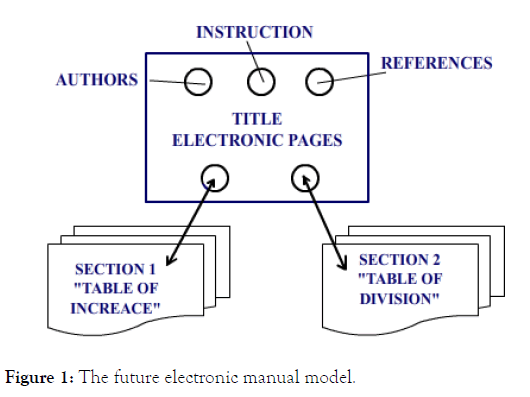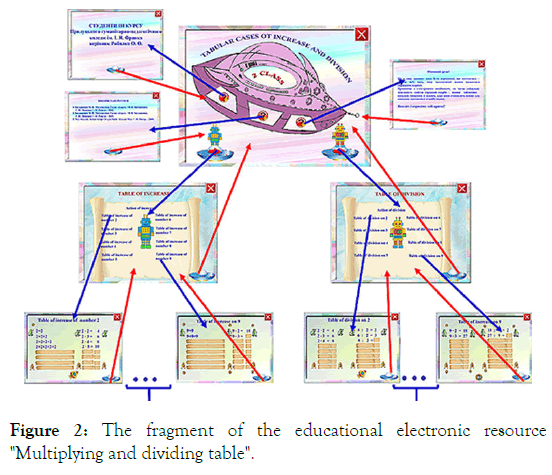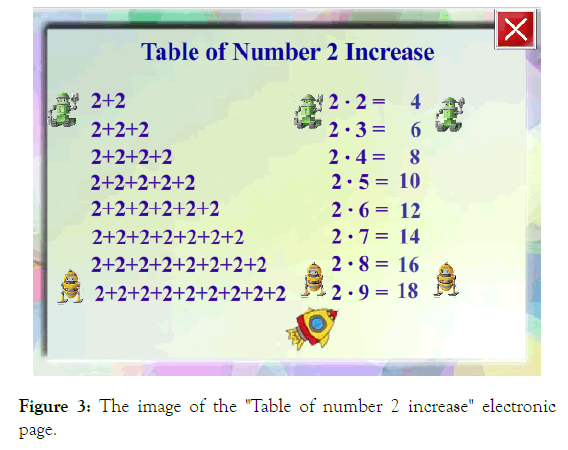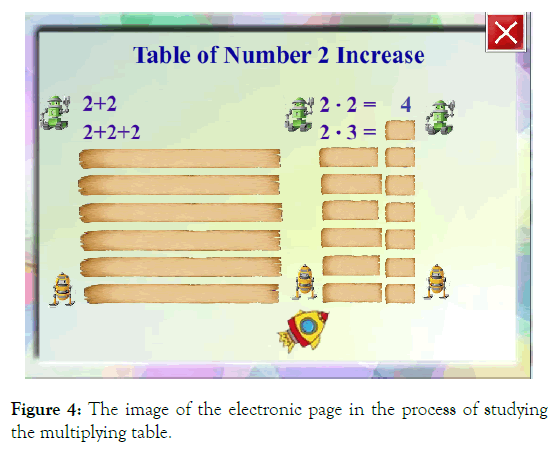International Journal of School and Cognitive Psychology
Open Access
ISSN: 2469-9837
ISSN: 2469-9837
Research - (2019)Volume 6, Issue 4
The article deals with the description of e-book maintaining that has interactive e-posters. The aim of such posters is to learn the presented tables of multiplying and dividing at primary school lessons for the second-year learners. The author describes the project work of students, the process of interactive e-poster detailed creation. The results of students` work are investigated at every step of e-resource creation. The workshop is of great importance for the future students` pedagogical activities. The author describes the created e-book and proves the importance of maintaining such educational facilities at primary school. Such facilities have highly estimated level, complexity and interactivity that become the most important aids for both students and school teachers at primary school at the lessons learning such topic as “Multiplying and Dividing Tables”. The scripts in the programming Action Script are developed by the author of the article. It caused the creation of this e-guide by means of Adobe Flash. Own technology for the design of interactive e-posters and methods of its usage were presented using the Adobe Flash system. The future teacher can create interactive electronic posters not only at Maths but also teaching other subjects.
Mathematics; Primary school; Interactive e-posters; Adobe flash; Action script
Problem formulation, the rapid development of IT in the educational process leads to the usage of electronic educational resources (EER) that have become an integral part of it. Despite the variety of subjects and topics developed by EER most teachers faced the problem of selecting quality resources which do not only have to meet the basic didactic, technical, ergonomic requirements [1] but would also be able to realize the author's ideas in teaching process. In this case, the actual ability of teachers to develop their own EER in support of subjects becomes relevant.
Visual teaching aids are a component of teaching system that can help younger schoolchildren learn the material with high quality at primary school [2]. As T. M. Klyueva claims that junior schoolchildren attention is supported by bright, Figurative, visual material, vivid and emotional activities. The child pays attention to the things that excite feelings and interest. Everything that is connected with the visual aids, impressions causes strong feelings and is remembered easily for a long time [3].
Various types of visual aids are used to being exercised in school education. Their role in the teaching process is very important especially in the case when the use of visual means of education becomes an integral part of learners` cognitive activity forming and developing visual, Figurative, abstract and logical thinking [4].
One of these types of visual facilities as sure to be interactive posters. Paper posters were used recently, later e-posters have appeared. The problem was that the learners used to see the notes. They had an excellent chance to answer the questions easily [5]. An interactive poster is an electronic educational tool of a new type that provides a high level of information channels engagement for the perception of the educational process. In the digital educational resources of this type information is not presented at once, it “appears” depending on the user's control actions. An interactive poster is means that allows to verify the level of immersion in a theme [6].
Researcher Kravchenya [7] claims that the information is assimilated by learners in the following way (Table 1): Considering the mentioned information, a teacher`s explanation and activity assisted with the demonstration of the relevant educational material using interactive posters can be attributed to the audio-visual perception which contributes to the learners` material maximum memorization. So, interactive e-posters are designed to help learners remember the best items of the material.
| The method of information presentation | 3-hour period saving information, % | 3-day period saving information, % |
|---|---|---|
| Explanation | 70 | 10 |
| Visual Perception | 72 | 20 |
| Audiovisual Perception | 85 | 50 |
Table 1: Memory storing information.
The students of Pryluky Humanitarian and Pedagogical College named after Ivan Franko (Ukraine) are used to conducting the lessons at primary school during the teaching practice. At Mathematics lessons in the second form the students noticed primary school learners remember the multiplying and dividing table badly. In order to help them both teachers and students decided to create electronic tutorial "Multiplying and Dividing Table".
College students have already experienced creating electronic educational resources for the first-year learners. They created electronic tutorial "Electronic Visual Facilities" [8] and "Adding and Subtracting Table to Number 10" [6]. The design of electronic educational resources prompts constant communication with junior learners and their problems which they come across in the process of learning primary school material.
Tasks are compiled on the materials of topic " Multiplying and Dividing Table" which is studied by the second-year learners. The workshop was created for the development of interactive eposters " Multiplying and Dividing Table " by the third-year students. They decided to use the experience of previous students who created e-resource "Electronic Visual Facilities" and worked according to the detailed plan mentioned in the previous article [9]. Initially, they identified the aim of the future EER. The students decided to create interactive e-tables to be used at Maths lessons at primary school that are sure to be used in learning topic "Multiplying and Dividing Table" by primary school learners as such tables are difficult to remember. The future teachers learned the teaching material which is in the second-year school textbooks. They determined the structure of the future EER at the stage of educational material structuring and logical systematization (Figure 1).

Figure 1. The future electronic manual model.
They have developed strategies according to which they made up their mind of the future educational e-resource design. They decided to take the same drawings for the title of e-pages as they are in electronic tutorial "Electronic Visual Facilities". The only element that they changed was the colour so that the picture can distinguish which form this e-resource was created for. College students worked at creating pictures. Some drawings for navigation were taken from the Internet. It was emphasized that site addresses should be clearly indicated on the "Information Resources" e-mail page. The design of the e-resource is one of the most important elements. Ergonomic requirements are to be considered. The navigation system should be very simple [10,11]. The students chose the program to create the electronic resource. In this case, they decided to use Adobe Photoshop, Adobe Flash CS3 Professional and Smart Install Maker 5.04. In Adobe Photoshop drawings and headings were created, in Adobe Flash CS3 interactive spreadsheets were presented and in Smart Install Maker 5.04 the distribution of the electronic tutorial was made. Two groups of students worked at the stage of the technical implementation of the project. The first group of students worked at creating posters that would enable younger learners to learn the multiplication table better. The second group worked with interactive posters. Each group identified the students who supervised the process of creating interactive posters and at its supervisors were responsible for the final result. The most responsible student was to control the creation of the title page and the implementation of the links between the components of the resource. The link between the elements of the e-resource was done using the built-in Action Script programming which is an Adobe Flash feature. It is impossible to develop a complete software product without the use of Action Script. Another student was selected to create the distribution which was developed in the Smart Install Maker 5.04 program.
The electronic educational resource was tested at each stage of its creation. The errors were discovered and fixed. All hyperlinks were verified that were implemented to using the buttons. The errors were discovered in the texts. This electronic resource was finally verified after creating the distribution.
At the end of the work written methodical recommendations were assigned to the created software. They contained information about the aim of the resource, structure, navigation buttons and their functions. The recommendations for the theoretical material on Mathematics textbooks, the procedure for working with electronic interactive posters were presented. Approval of the educational electronic resource took place at Maths lessons conducted by future teachers at primary school. The students were sure that the electronic resource was of great importance for primary school learners. The analysis of the results of educational electronic resources introduction was conducted in order to reveal the pedagogical properties of software products.
The project manager (the author of the article) developed the scripts in programming Action Script which made it possible to create this electronic guide. Own technology of interactive electronic posters using Adobe Flash system and methods of usage were presented. A future teacher can conduct a lesson communicating with younger learners at the stage of assimilating the new material, consolidating it or testing knowledge using this technique. Figure 2 depicts the fragment of created e-resource that contains interactive posters for learning multiplication and division tables in better use at primary school.

Figure 2. The fragment of the educational electronic resource "Multiplying and dividing table".
The navigation buttons (Figure 2) are shown through which the transition between the electronic pages of the manual is depicted. The blue arrows show how to navigate to the selected page but using the red arrows it is possible to see how to navigate from the electronic page to the title page and the main pages of the relevant sections.
From the title page the user has the opportunity to go to the electronic pages: "Information Resources", "Authors", "Instruction". This can be done by clicking on the buttons with the image of the question mark. You can go to the title page of the selected one by clicking the left mouse button on the image.
There are buttons with images of robots on the title page. With their help the user has the opportunity to go to the electronic pages on which he has the opportunity to select appropriate cases of a multiplication or division table. Blue robot is responsible for studying the multiplication table, yellow robot is responsible for studying the division table. For example, by choosing a blue robot button, we go to the electronic page where it is possible to choose the electronic page to study the multiplication table of a particular numeric. To do this put the left mouse button on the corresponding inscription and click on it. All inscriptions are buttons. Left-clicking on one of them allows you to go to the corresponding e-mail page. To study the multiplication table for such electronic pages, it is planned to 8 (table of increase of numbers: 2, 3, 4, 5, 6, 7, 8, 9). To study the division table, 8 electronic pages are also scheduled (dividing table into numbers: 2, 3, 4, 5, 6, 7, 8, 9).
Click the left mouse button on the inscription "Table of number 2 increase" and proceed to the corresponding electronic page (Figure 3).

Figure 3. The image of the "Table of number 2 increase" electronic page.
Firstly, the electronic page that has opened shows all the records that appear. By clicking on images of robots painted in yellow it is possible to close all records (Figure 4). By clicking the left mouse button on the images closing the record it is possible to open them gradually. A future teacher has the opportunity to open the necessary material when it is convenient for him (Figure 4).

Figure 4. The image of the electronic page in the process of studying the multiplying table.
For example, the process of work after the pupils answer the question is in action. Comparing with paper posters the use of interactive e-posters has several advantages. Learners do not see the answers to the questions asked by the teacher. This encourages them to think about them and to draw conclusions. As the students made interactive posters for using during the lessons at primary school, they decided to create buttons that allow to open all records of the corresponding column. So, by clicking on the image of the robots painted in green it is possible to open all the corresponding records. This option was offered by the students for quick opening the records when needed.
This manual can be used not only in the process of learning the new teaching material but also during the final lessons of conclusions. Learners can work either at home with their parents or on their own. For this record the pictures on the left should not be opened at all. They need to be used only at the stage of learning the new material. The records of the second and third columns should be used at the stage of the studied material repetition or verification. A learner is given the task, the corresponding entry is opened. Only after a learner thinks and answers, the corresponding entry in the third column is opened. In this way, the user has the ability to work with all pages of the electronic manual.
Besides, this e-book is highly estimated by parents. They have got an excellent opportunity to practice such tables at home. Learners have got a possibility to train multiplying and dividing at home on their own repeating the material at home again. Their parents can check learners` knowledge. Such work is usually conducted in the form of a game. Necessary examples are opened and then learners answer the questions. It is possible for them to check if the answers are correct.
In each country there are different approaches of learning the tables of multiplication and division. It's very easy to adapt this tutorial to the textbooks of Mathematics in different countries. In addition, such interactive posters can be created for the computer support in any subject.
The Students of Pryluky Humanitarian Pedagogical College had the opportunity to use this electronic manual at Mathematics lessons in the second form. They are aids that can be used at different levels of learning to get new knowledge, to improve skills at the stage of learners` educational achievement verification and correction. This contributes to both teachers and learners` intensification of work. The material of the manual is accessible to primary school learners. The use of this electronic manual has the aim to improve the quality of education and to increase primary school learners` cognitive interest. The use of this manual helps to improve the educational process, develops creativity and is of great interest to learners. It contributes to the intensification of the educational process, the rational organization of children and teachers` work at the lessons learning topic "Multiplying and Dividing Table" that allows to attract effective teaching methods and establish good feedback.
However, the created e-book "Multiplying and Dividing Table" does not satisfy all the facility needs of primary school teachers in the educational process by means of poster training. Further research requires the development of other types of visual facilities for both integrated learning school subjects and disabled learners` training. In our opinion, the promising area of further research is to improve students` work at educational e-resources creation in order to provide primary school educational process with electronic teaching aids in education.
Citation: Rybalko O (2019) College Students Interactive E-Poster Project Work. Int J Sch Cogn Psychol 6:219. DOI: 10.35248/2469-9837.19.6.219
Received: 11-Nov-2018 Accepted: 31-Jan-2019 Published: 11-Feb-2019 , DOI: 10.35248/2469-9837.19.6.219
Copyright: © 2019 Rybalko O. This is an open access article distributed under the term of the Creative Commons Attribution License, which permits unrestricted use, distribution, and reproduction in any medium, provided the original work is properly cited.